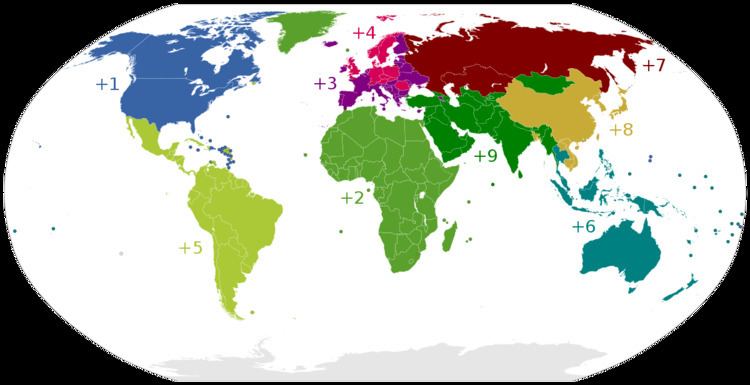 | ||
Canada, the United States and some Caribbean countries use the country calling code 1. Local area codes in these countries are managed by the North American Numbering Plan.
Contents
Greenland and Aruba have a country calling code that has the number "2" as first digit, which mostly is used by countries in Africa. All other countries use codes that start with "5".
North American Numbering Plan
Country Code: +1
International Call Prefix: 011
Trunk Prefix: 1
In the United States (including its territories), Canada, Bermuda, and 18 Caribbean nations, area codes are regulated by the North American Numbering Plan. Currently, all area codes (officially called numbering plan areas) in the NANP must have 3 digits. Historically, the second digit was always "0" or "1", while the second digit of the 3-digit exchange prefix was never "0" or "1." With the increased demand for area codes because of additional lines, FAX lines, pagers, cell phones, etc., the restrictions on the second digit were lifted in 1995. At the same time, the historic restriction on a local (7-digit) telephone number's second digit, which previously could not be a "0" or "1" (to avoid confusion with area codes), was also lifted. Under the new rules, a telephone number such as (378) 400-1234 is perfectly legal, whereas before 1995 it was not permitted.
Despite being one numbering plan, the cost of calling numbers in the NANP (both from inside and from outside) can vary widely depending on which country of the NANP the code is in. As a result, great care is needed on the part of a caller to avoid unexpectedly large bills.
Not all area codes correspond to a geographical area. Codes 8xx (excluding 811 and 899) with the last two digits matching, such as 800, 888, 877, 866, etc., are reserved for toll-free calls. Code 900 is reserved for premium-rate calls (also known as dial-it services, although such services also exist in some places on a local basis using a particular three-digit prefix following the area code, often "976" or "540"). Area code 710 is reserved for the United States Government. Area code 600 is reserved for national Canadian services.
Mobile phones are normally allocated numbers within regular geographic area codes corresponding to or close to the subscriber's home or work location, instead of within a distinctive subset of area codes. (The exception to this rule is New York City, where new mobiles are usually allocated numbers from the 917 area code.) All the extra costs of mobile telephony must be borne by the mobile's owner, unlike in many countries where calling mobiles costs significantly more than calling landlines. Local number portability (LNP) applies across landline and mobile services. In some regions, customer can port a landline number to mobile service and vice versa.
Dialing plans vary from place to place depending on whether an area has overlays (multiple area codes serving the same area) and whether the state requires toll alerting (a leading 1+ for toll calls). The NANPA web site includes dialing plan information in their information on individual area codes.
In areas without overlays and without toll alerting, including much of California, Illinois, New York (excluding New York City, see below), and New Jersey, calls within an area code are dialed as seven digits (7D) and calls outside the area code as 1 followed by 10 digits (1+10D). Most areas allow permissive dialing of 1+10D even for calls that could be dialed as 7D. The number of digits dialed is unrelated to whether a call is local or toll. In some places, local calls to other area codes are 1+10D, in others they can be dialed as 10D without the leading 1.
In areas with overlays, local calls are all dialed as either 10D or 1+10D; this varies by area. (In New York City, the preferred form is 1+10D but 10D also works.) In areas without toll alerting, all calls to numbers within the caller's area code and overlay codes serving the same area can be dialed as either 10D or 1+10D, while calls to other area codes must be 1+10D. In areas with toll alerting, all toll calls must be dialed as 1+10D.
Most areas permit local calls to be dialed as 1+10D except for California, Oregon, Texas, parts of Florida (such as Miami) and many parts of Canada (such as Ontario) which requires that callers know which numbers are local and which are toll, dialing 10D for all local calls and 1+10D for all toll calls
Mobile phone users in North America are not generally required to dial 1, but do need to dial 10D for calls within the North America numbering plan unless:
Listing
(initial ordering by country)
